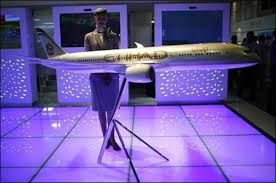 Etihad Airways’ strategy of stitching together alliances and making equity investments in airlines around the world has been dubbed by an aviation journal as one of empire-building.
Etihad Airways’ strategy of stitching together alliances and making equity investments in airlines around the world has been dubbed by an aviation journal as one of empire-building.
Smaller in size than some of its acquisitions (both airberlin and Jet Airways, in which Etihad holds significant stakes, have larger fleets and flew more passengers last year), Etihad has seven airlines in its kitty.
Its latest acquisition, Darwin Air, is a small Swiss airline and is being rebranded as Etihad Regional.
The Abu Dhabi-based airline has used the investments to widen its own footprint and is driving changes in its partner airlines. Some of the moves are yielding results.
Germany’s airberlin turned profitable (a profit of 6.8 million euros or Rs 57.8 crore) in 2012, though the gain was partly due to the sale of its airline frequent flyer programme to Etihad.
This was the airline’s first annual profit in five years. Air Seychelles, too, has turned around its operations making a profit of a million dollar in 2012, its first in three years.
The question is whether Etihad’s Rs 2,069-crore (Rs 20.69-billion) investment will revive Jet Airways’ fortune or not.
The Indian airline is deep in loss, having a negative networth and a debt burden of over Rs 11,000 crore (Rs 110 billion).
Critics argue that Etihad’s larger interest in investing in India lies in tapping the market and its decision to invest in Jet Airways is guided by this logic.
While this may be true, the alliance does open up potential benefits for both partners.
Founded in 2003, Etihad has followed a strategy different from its peers because of sheer scale.
Over 40 code-share pacts and investments in airlines have helped Etihad expand its network and increase its revenue.
It integrates the partner airline’s network with its own to develop Abu Dhabi as a hub.
For instance, it connects passengers from Germany to Seychelles via Abu Dhabi through code shares.
Direct options are limited, so Abu Dhabi competes with Nairobi and Addis Ababa (Ethiopia) for the Europe-Seychelles market.
The other benefits of its model lie in cost savings and synergies achieved through common fleet planning and acquisition, single maintenance contracts and joint training of pilots and crew.
Jet Airways, airberlin and Etihad have forged common contracts for seats, in-flight entertainment systems, engines and maintenance for Boeing 787 planes.
“The deals give airberlin and Jet access to economies of scale they would not otherwise have on the 787, thereby, reducing costs. Jet and airberlin have 10 and 15 787s on order, respectively.
Etihad has a larger order of 41 aircraft, with deliveries starting in late-2014.
In addition to resulting in lower costs for the three carriers, the deals will give a common on-board experience across their 787 fleets,” the Centre for Asia Pacific Aviation says in its report.
For example, Air Berlin’s flat business-class seats in its Airbus A330s resemble Etihad’s.
Air Seychelles is revamping its fleet by inducting new Airbus A330s and leasing A320 planes from Etihad.
The airline had said it was successful in reducing costs and improving service because of re-negotiation of contracts for catering, ground handling and in-flight entertainment and the conclusion of joint contracts for fuel, uniforms and stationery supplies, while announcing last fiscal’s results.
Etihad and Jet are expected to work out similar co-operating strategies but have not divulged the details yet. Etihad did not respond to an email query on the subject.
Along with equity infusion, Etihad has also granted loans to its partner airlines: $25 million (or Rs 154 crore) to Air Seychelles and $60 million (or Rs 370 crore) to Air Serbia.
The airline will also help Jet Airways raise $150 million (or Rs 926 crore) loan which will be used to repay its high-cost debt.
Kapil Kaul of Centre for Asia Pacific Aviation says, “Etihad’s investment will bring in positive changes at Jet, including a more professional management.
Turnaround, especially, in Jet’s domestic business will take longer than expected.
"The key objective of Etihad, which is to drive more traffic to Abu Dhabi as a hub, will be realised before the financial turnaround. Jet’s domestic business is contributing to 70-80 per cent in losses.
"We expect that more clarity will emerge on its business model -- whether Jet will return to just a full-service model or not.
Etihad is expanding its own operations and making new investments. For it, maintaining the management focus will be critical.”
“Etihad brings financial clout and expertise.
"Nevertheless, the challenges of the task cannot be underestimated.
"There are many challenges in the market including high taxes, fuel prices and government support of Air India,” says UK-based aviation consultant John Strickland.
However, others are more critical of Etihad’s agenda.
“Etihad is interested in Jet as a life-support system. Jet gives access to the Indian market and slots at Indian airports.
"Once the Etihad directors sit on the Jet board, they will realise that their best approach to bolster the feed for Etihad is to get Jet to make money,” says Andrew Charlton, founder and CEO of Aviation Advocacy, an aviation consultancy firm.
Existing management bandwidth is key
In an interview with Flightglobal, an online aviation news provider, Etihad CEO James Hogan listed the criteria to consider a strategic investment: Network compatibility , opportunities for scaling up and reorganisation, and a good existing management team.
“In the investments we look at, we put in management teams – but they report to a board. We have representatives on the board, but those CEOs are responsible for their own day-to-day business,” he says.
“This is the big difference when people say Swissair tried this. Swissair took management control,” he says.
(Swiss Air, which shut down in 2001 due to financial problems, had followed an expansion strategy that involved picking up stakes in various airlines in Europe)












 © 2025
© 2025